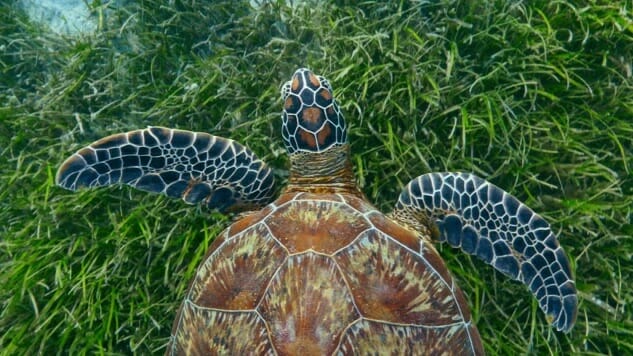Bleeding Fingers Music Collective on Scoring Blue Planet II

Hopefully you’ve been watching the landmark followup to David Attenborough’s Blue Planet docuseries on BBC America (if you haven’t, you need to. Really.) The new series, 10 years after its beautiful, celebratory original, has modulated to reflect not only the oceans’ spectacular abundance and diversity and our inextricably connected relationship with them, but also the growing alarm that human carelessness might be reaching a point that even our relentlessly self-renewing ocean ecosystems cannot keep up with.
Imagine you’ve been given the formidable task of composing the soundscape for such a far-reaching endeavor. I personally couldn’t, so luckily I got a chance to chat with members of Bleeding Fingers, the music collective responsible for the beautiful score for Blue Planet 2. We caught up with Jacob Shea and David Fleming, who served as the lead composers, and Russell Emmanuel, CEO of Bleeding Fingers and creative producer for this score.
Paste: I’m familiar with some, but not all, of the work from this collective. I’m curious about the super-basics of composing for this program: what was the process, what were the constraints, what were the challenges, how much leeway did the composers have versus how much directive from production staff, that kind of thing?
Russell Emanuel: Good question. You know, these big projects are extremely ambitious. The challenge is like scoring 4 movies at once in one go. You need to assemble a crack team of composer’s assistants, as well as highly talented producers. The main challenges came from the logistics of putting that whole thing together. You know you’re going to be working on something like this for 9 months or so. As the process moves along, the timeline gets shorter and shorter and the challenges seem to get larger. The initial hurdle is assembling the team, but we’re very lucky that the people here came up working for Hans Zimmer, so they’re used to challenging deadlines and juggling numerous projects. These are challenges we have, not just in Blue Planet II, but in every project we do. Everyone wants the music tomorrow, and everyone wants the music to sound finished now. It’s just the everyday stuff. I think with any project like this, it always starts with a luxury of time, and then you slowly progress into the craziness of a deadline.
Paste: I know a lot of composers use animal sounds as “instruments” in composition (Bernie Krause comes to mind). I know that the first time I was on a whale-watching tour during humpback mating season, it was all spectacular to watch but what really blew my mind was when the naturalist on the boat dropped a mic in the water. I can’t imagine not being stunned by the sheer range and volume of communicative noise going on within a few hundred yards of the boat. To what extent were you inspired or influenced by the actual sounds of marine life?
Jacob Shea: With Dave and I, and for Russell at the outset, we wanted to mimic the water itself: to create a tapestry, a texture and a style of writing that was analogous to the undulation of the sea. Something to make you consider the fact that you’re not really on terra firma. The concept wasn’t specifically focused on the animals, but more on going in with our orchestra and recording these high, wave-like gestures and use those as the bedrock of each piece of music.
David Fleming: One thing we would actually do, is stay out of the way of the animals themselves, in terms of the audio that was captured. By focusing more on the connective tissue of “how do we tell the story of the ocean,” and by using this idea of a tidal orchestra, we could let David Attenborough or the animal, whether it be surfing dolphins or a sucker fish breaking open a shell, stand in as the lead instrument that we accompany.
Paste: The sound in general really stands out to me as one of the strengths of the program, which, given the quality of the photography, is saying a lot. Not only “score” per se but the whole soundscape-I’ve been in water with dolphins, parrotfish, turtles; it’s surprisingly noisy down there (in shallow water anyway). Was the entirety of the soundscape you guys or was there a lot of interplay with a larger sound design team? They must have captured a lot of sound with principal photography.
Shea: When we got each episode, Dave and I would make a conscious effort to be aware of the sound effects that were laid in, and to make room for them in our orchestration so that they could live together. In terms of a closer collaboration, I would’ve welcomed it, it just didn’t happen on this one.
Fleming: Although it wasn’t our purview to handle the actual audio, we were always conscious of it, like Jacob said. From my understanding, most of it is sourced, meaning it’s the actual audio being caught from the footage. The technology has changed drastically. Obviously, the camera technology and image quality has gotten so much better in recent years, but what a lot of people don’t realize how good the audio capturing has gotten in camera. I was pretty blown away by some of the sounds they recorded, especially when I found out that they were real and sourced directly.
Paste: I wasn’t actually sure how much of it was sourced directly-that is amazing. So, personally, one of the things that would give me panic attacks about a project like this would be moving-target deadlines! How much time did you generally have to compose, between receiving footage and having to deliver a score?
-

-

-

-

-

-

-

-

-

-

-

-

-

-

-

-

-

-

-

-

-

-

-

-

-

-

-

-

-

-

-

-

-

-

-

-

-

-

-

-








































